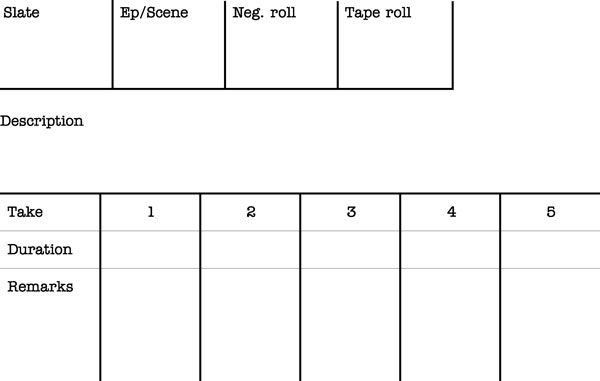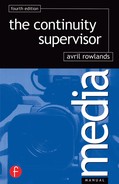There are two ways of providing the editor with all the information he or she requires when working on a scripted production.
Typed –Up Continuity Report Sheets
You can type up all your rough notes on to a continuity report sheet and give it to the editor. That is the system most people follow and one which I used myself for many years until I happened to mention to my husband, who is an editor, that all the additional typing in hotel bedrooms late at night or early in the morning was, for me, the one big drawback to the job.
His reply surprised me, for he said that he did not need half the information which had been so painstakingly given to him. For example, he was not interested in knowing what costumes the artists wore – provided that continuity of costume was correct from shot to shot and scene to scene. Likewise the full description of the shot did not interest him. He did not need to be told that Jim entered shot frame L – walked R to the table – sat down – picked up the full glass of beer (with his right hand) etc. He had only to look at the relevant picture to find all that out!
So together we devised a far simpler way of providing the editor with the information he or she really does need.
Continuity Cards
The cards contain only the barest information about the shot, but it is information which the editor really needs: the scene; the slate number or ‘in’ point of timecode; the camera or tape roll number and the sound roll number. Make a note if the take is sync or mute and use a separate card for wildtracks. Apart from that, the editor will want a brief description of the shot, e.g. W/A Henry’s kitchen, and finally give details about the takes: how many there were, which were NG and why, and which were acceptable. Nothing else is necessary apart from an accurately marked-up coverage script to tell him or her what part of the scene was covered by each shot.
The cards are simplicity itself, but it is only fair to say that some editors do not like working with them – they prefer pieces of paper which they can place in a file. There is, of course, no reason why the basic information the editor needs should not be written on a piece of paper rather than a card. The important point is to give the editor the information he or she wants and not a lot of extraneous detail which will never be read, but which has caused you hours of unnecessary work.

Continuity sheet for the editor

Continuity card

